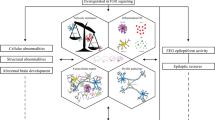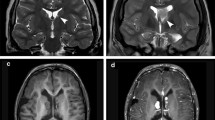Abstract
Autism and pervasive developmental disorders (PDD) are common in tuberous sclerosis (TSC). The frequency of autism is about 25%, with 40–45% of TSC cases meeting criteria for autism or PDD. Among autistic populations, the frequency of TSC is 1–4% and perhaps as high as 8–14% among the subgroup of autistic individuals with a seizure disorder. Mental retardation (MR) and seizures, particularly infantile spasms, are significant risk factors in the development of autism/PDD in TSC; however, neither are sufficient or necessary for the development of these behaviors. The mechanism underlying the association of autism and TSC is as yet unclear but clinical features and neuroimaging investigations suggest that an abnormal TSC gene may directly influence the development of autism rather than it being a secondary effect of seizures or MR. The presence of autism/PDD may arise if the TSC gene mutations occur at critical stages of neural development in neural tissue of brain regions critical in the development of autism.
Similar content being viewed by others
REFERENCES
Bailey, A., Phillips, W., & Rutter, M. (1996). Autism: Towards an integration of clinical, genetic, neuropsychological, and neurobiological perspectives. Journal of Child Psychology and Psychiatry, 37, 89–126.
Bolton, P. F., & Griffiths, P. D. (1997). Association of tuberous sclerosis of temporal lobes with autism and atypical autism. Lancet, 349, 392–395.
Carbonara, C., Longa, L., Grosso, E., Borrone, C., Garre, M. G., Brisigotti, M., & Migone, N. (1994). 9q34 loss of heterozygosity in a tuberous sclerosis astrocytoma suggests a growth suppressor-like activity also for the TSC1 gene. Human Molecular Genetics, 10, 1829–1832.
Curatolo, P. (1996). Neurological manifestations of tuberous sclerosis complex. Children's Nervous System, 9, 515–521.
Curatolo, P., & Cusmai, R. (1987). Autism and infantile spasms in children with tuberous sclerosis. Developmental Medicine and Child Neurology, 29, 550–551.
European Chromosome 16 Tuberous Sclerosis Consortium. (1993). Identification and characterization of the tuberous sclerosis gene on chromosome 16. Cell, 75, 1305–1315.
Fryer, A. E., Chalmers, A., Connor, J. M., Fraser, I., Povey, S., Yates, A. D., Yates, J. R., & Osborne, J. P. (1987). Evidence that the gene for tuberous sclerosis is on chromosome 9. Lancet, 8534, 659–661.
Geist, R. T., & Gutmann, D. H. (1995). The tuberous sclerosis 2 gene is expressed at high levels in the cerebellum and developing spinal cord. Cell Growth & Differentiation, 6, 1477–1483.
Gillberg, C. (1991). The treatment of epilepsy in autism. Journal of Autism and Developmental Disorders, 21, 61–77.
Gillberg, C., & Coleman, M. (1992). The biology of the autistic syndromes (2nd ed.). Clinics in Developmental Medicine No. 126. London/New York: Mac Keith with Cambridge University Press.
Gillberg, I. C., Gillberg, C., & Ahlsen, G. (1994). Autistic behavior and attention deficits in tuberous sclerosis: A population-based study. Developmental Medicine and Child Neurology, 36, 50–56.
Gomez, M. R. (1988). Tuberous sclerosis (2nd ed.). New York: Raven.
Gonzalez, R. C., Welsh, J. T., & Sepulveda, A. C. (1993, November 3). Autismo en la esclerosis tuberosa. Leido, pp. 374–379.
Green, A. J., Smith, M., & Yates, J. R. (1994). Loss of heterozygosity on chromosome 16p13.3 in hamartomas from tuberous sclerosis patients. Nature Genetics, 2, 193–196.
Green, A. J., & Yates, J. R. W. (1993). Loss of heterozygosity and chromosome 16p and harmatomata from patients with tuberous sclerosis. American Journal of Human Genetics, 53, 244.
Gutierrez, G. C., Smalley, S. L., & Tanguay, P. E. (1998). Autism in tuberous sclerosis complex. Journal of Autism and Developmental Disorders, 28, 97–103.
Halley, D. J. (1996). Tuberous sclerosis: Between genetic and physical analysis. Acta Geneticae Medicae et Gemellologiae (Rome), 45, 63–75.
Henske, E., Neumann, H. P. H., Scheithauer, B. W., Herbst, E. W., Short, M. P., & Kwiatkowski, D. J. (1995). Loss of heterozygosity in the tuberous sclerosis (TSC2) region of chromosome band I6pI3 occurs in sporadic as well as TSC-associated renal angiomyolipomas. Genes, Chromosomes & Cancer, 13, 295–298.
Hunt, A. (1983). Tuberous sclerosis: A survey of 97 cases, I: Seizures, pertussis immunization and handicap. Developmental Medicine and Child Neurology, 25, 346–349.
Hunt, A., & Shepherd, C. (1993). A prevalence study of autism in tuberous sclerosis. Journal of Autism and Developmental Disorders, 23, 323–339.
Hunt, A., & Dennis, J. (1987). Psychiatric disorder among children with tuberous sclerosis. Developmental Medicine and Child Neurology, 29, 190–198.
Hunt, A. (1993). Development, behavior and seizures in 300 cases of tuberous sclerosis. Journal of Intellectual Disability Research, 37, 41–51.
International Molecular Genetic Study of Autism Consortium (1998, March). Human Molecular Genetics, 7, 571–578.
Jambaque, I., Cusmai, R., Curatolo, P., & Cortesi, F. (1991). Neuropsychological aspects of tuberous sclerosis in relation to epilepsy and MRI findings. Developmental Medicine and Child Neurology, 33, 698–705.
Janssen, B., Sampson, J., van der Est, M., Deelen, W., Verhoef, S., Daniels, I., Hesseling, A., Brock-Carter, P., Nellist, M., Lindhout, D., Sandkuijl, L., & Halley, D. (1994). Refined localization of TSC1 by combined analysis of 9q34 and 16p13 data in tuberous sclerosis families. Human Genetics, 94, 437–440.
Kandt, R. S., Haines, J. L., Smith, M., Northrup, H., Gardner, R. J. M., Short, M. P., Dumars, K., Roach, E. S., Steingold, S., Wall, S., Blanton, S., Flodman, P., Kwiatkowski, D. J., Jewell, A., Weber, J. L., Roses, A. D., & Pericak-Vance, M. A. (1992). Linkage of an important gene locus for tuberous sclerosis to a chromosome 16 marker for polycystic kidney disease. Nature Genetics, 2, 37–41.
Kanner, L. (1943). Autistic disturbances of affective contact. Nervous Child, 2, 217–250.
Kobayashi, T., Hirayama, Y., Kobayashi, E., Yoshiaki, K., & Hino, O. (1995). A germline insertion in the tuberous sclerosis (Tsc2) gene gives rise to the Eker rat model of dominantly inherited cancer. Nature Genetics, 9, 70–74.
Le Couteur, A., Rutter, M., Lord, C., Rios, P., Robertson, S., Holdgrafer, M., & McLennan, J. (1989). Autism Diagnostic interview: A standardized investigator-based instrument. Journal of Autism and Developmental Disorders, 19, 363–386.
Lord, C., Rutter, M., Goode, S., Heemsbergen, S., Jordan, J., Mawhood, L., & Schopler, E. (1989). Autism diagnostic observation schedule: A standardized observation of communicative and social behavior. Journal of Autism and Developmental Disorders, 19, 185–212.
Lord, C., Rutter, M., & Le Couteur, A. (1994). Autism Diagnostic Interview—Revised: A revised version of a diagnostic interview for caregivers of individuals with possible pervasive developmental disorders. Journal of Autism and Developmental Disorders, 24, 659–685.
Osborne, J. P., Fryer, A., & Webb, D. (1991). Epidemiology of Tuberous Sclerosis. In W. G. Johnson & M. R. Gomez (Eds.), Tuberous sclerosis and allied disorders (pp. 125–139). New York: New York Academy of Sciences.
Piven, J., Chase, G. A., Landa, R., Wzorek, M., Gayle, J., Cloud, D., & Folstein, S. (1991). Psychiatric disorders in the parents of autistic individuals. Journal of the American Academy of Adolescent Psychiatry, 30, 471–478.
Riikonen, R., & Simmell, O. (1990). Tuberous sclerosis and infantile spasms. Developmental Medicine and Child Neurology, 32, 203–209.
Riikonen, R., & Amnell, G. (1981). Psychiatric disorders in children with earlier infantile spasms. Developmental Medicine and Child Neurology, 23, 747–760.
Smalley, S. L. (1995). Autism and tuberous sclerosis. Psychiatric Genetics, 5, S88.
Smalley, S. L., Burger, F., & Smith, M. (1994). Phenotypic variation of tuberous sclerosis in a single extended kindred. Medical Genetics, 31, 761–765.
Smalley, S. L., Levitt, J., & Bauman, M. (1998). Autism: Diagnosis, Etiology, and Treatment. In C. E. Coffey & R. A. Brumback (Eds.), Textbook of pediatric neuropsychiatry. Washington, DC: American Psychiatric Press.
Smalley, S. L., McCracken, J., & Tanguay, P. (1995). Autism, affective disorders, and social phobia. American Journal of Medical Genetics, 60, 19–26.
Smalley, S. L., Tanguay, P. E., Smith, M., & Gutierrez, G. (1992). Autism and tuberous sclerosis. Journal of Autism and Developmental Disorders, 22, 339–355.
van Slegtenhorst, M., Hoogt, R., Hermans, C., Nellist, M., Janssen, B., Berhoef, S., Lindhout, D., van den Ouweland, A., Halley, D., Young, J., Burley, M., Jeremiah, S., Woodward, K., Nahmias, J., Fox, M., Ekong, R., Wolfe, J., Povey, S., Osborne, J., Snell, R., Cheadle, J., Jones, A., Tachataki, M., Ravine, D., Sampson, J., Reeve, M., Richardson, P., Wilmer, F., Munro, C., Hawkins, T., Sepp, T., Ali, J., Ward, S., Green, A., Yates, J., Short, M., Haines, J., Jozwiak, S., Kwiatkowska, J., Henske E., & Kwiatkowski, D. (1997). Identification of the tuberous sclerosis gene TSC1 on Chromosome 9q34. Science, 277, 805–808.
Wienecke, R., Maize, J. C., Reed, J. A., de Gunzburg, J., Yeung, R. S., & DeClue, J. E. (1997). Expression of the TSC2 product tuberin and its target RAP 1 in normal human tissues. American Journal of Pathology, 150, 43–50.
Wilson, P. J., Ramesh, V., Kristiansen, A., Bove, C., Jozwiak, D., Kwiatkowski, D. J., Short, M. P., & Haines, J. L. (1996). Novel mutations detected in the TSC2 gene from both sporadic and familial TSC patients. Human Molecular Genetics, 5, 249–256.
Xiao, G.-H., Shoarinejad, F., Jin, F., Golemis, E. A., & Yeung, R. S. (1997). The tuberous sclerosis 2 gene product, tuberin, functions as a RabS GTPase activating protein (GAP) in modulating endocytosis. Journal of Biological Chemistry, 272, 6097–6100.
Yeung, R. S., Xiao, G.-H., Jin, F., Lee, W-C., Testa, J. R., & Knudson, A. G. (1994). Predisposition to renal cell carcinoma in the Eker rat is determined by germline mutation of the tuberous sclerosis 2 (TSC2) gene. Proceedings of the National Academy of Science (U.S.), 91, 11413–11416.
Author information
Authors and Affiliations
Rights and permissions
About this article
Cite this article
Smalley, S.L. Autism and Tuberous Sclerosis. J Autism Dev Disord 28, 407–414 (1998). https://doi.org/10.1023/A:1026052421693
Issue Date:
DOI: https://doi.org/10.1023/A:1026052421693




